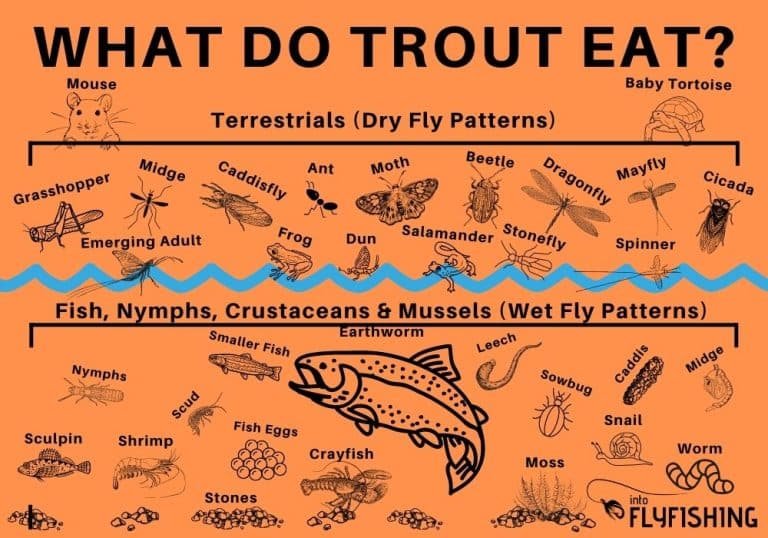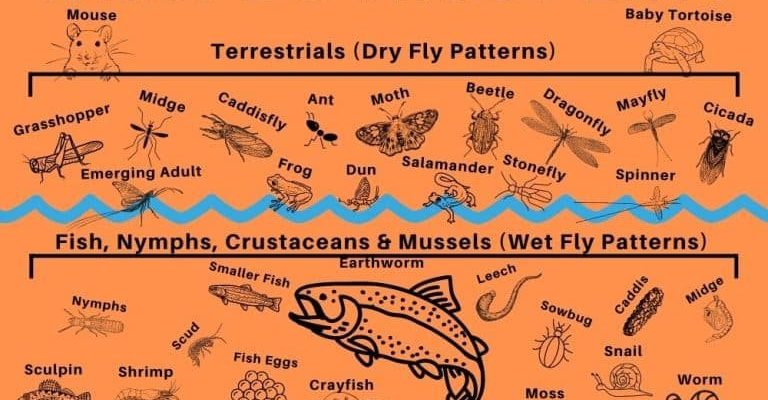
Trout are interesting creatures. They thrive in freshwater environments and have a diverse diet that includes insects, smaller fish, and plant matter. If you’re hoping to catch some trout or just want to know more about these fascinating fish, you’re in the right place! In this guide, we’ll dive deep into what trout eat, their feeding schedule, and how to ensure they get the nutrition they need.
Understanding Trout Diet
When it comes to the diet of trout, it’s essential to recognize that these fish are opportunistic feeders. This means they’ll eat whatever is available to them. Think of them as the ultimate foodies of the fish world. Trout primarily consume:
- Insects: Aquatic insects are a staple, especially mayflies, caddisflies, and stoneflies.
- Small Fish: Trout will also hunt smaller fish like minnows and other juvenile fish.
- Crustaceans: Depending on their habitat, they’ll munch on shrimp and crayfish.
- Plant Matter: While not a mainstay, some trout eat algae and other aquatic plants.
The specific items they consume can vary by species and location. For example, brown trout are known to have a more varied diet, while rainbow trout might lean heavily towards insects and small crustaceans.
Feeding Habits of Trout
Trout have different feeding habits based on the time of day. Generally, they are most active during dawn and dusk. This is when they really come alive and start hunting. It’s like how you might enjoy a late-night snack when the cravings hit!
You might wonder why they’re more active at these times. It’s all about visibility and opportunity. During these low-light periods, insects are more likely to be on the water’s surface, making it easier for trout to grab a bite without much effort. As a result, if you’re fishing, aim for those early or late hours for the best chance of a catch.
Another factor to consider is water temperature. In warmer waters, trout tend to be more active, while in cooler waters, their metabolism slows down significantly. This means they won’t need as much food and may not feed as aggressively. It’s similar to feeling hungrier on a hot summer day compared to a chilly one!
The Importance of Aquatic Insects
Aquatic insects are a key part of a trout’s diet, especially during their larval stage. Imagine these tiny critters as the fast food of the trout world—easily accessible and packed with nutrients.
Trout will usually find insects that haven’t yet hatched, making them an even more significant part of their diet during certain seasons. Mayflies, for example, might hatch by the thousands in the spring. A trout finding such a buffet is like you stumbling upon an all-you-can-eat buffet of your favorite food!
Insect hatches can vary, so understanding when they occur in your fishing area can give you a huge advantage. It’s a good idea to keep an eye on the types of insects around—you may want to mimic these in your fishing lure.
Nutritional Needs of Trout
Trout, like all living creatures, need a balanced diet to thrive. Their nutritional needs will differ based on their age and the specific species. Generally, they require a mix of:
- Proteins: Essential for growth and development, especially in young trout.
- Fats: Important for energy, particularly in colder water when their metabolism slows.
- Vitamins and Minerals: Necessary for overall health, including bone formation and immune function.
As a fishkeeper or angler, it’s important to provide the right balance of these nutrients if you want the trout to be healthy and lively. Just like you wouldn’t want to live off junk food alone, trout need variety, too!
Feeding Schedule for Trout
Creating a feeding schedule can be crucial, especially if you’re raising trout. Here’s how to set one up:
1. Young Trout: For younger trout, aim to feed them several small meals throughout the day. They’re growing quickly and need constant nourishment—think of it like a teenager with an insatiable appetite.
2. Adult Trout: Adults typically eat less frequently, around once a day or every other day. Their slower metabolism means they don’t need as much food, but make sure it’s packed with the nutrients they need.
3. Seasonal Changes: Keep in mind that in colder months, you might need to reduce their food intake. Water temperatures drop, so their metabolism does too, requiring less frequent feeding.
What’s crucial is monitoring how much they’re eating. If you notice leftover food, it’s a sign you’re overfeeding, which can harm water quality in your aquarium or wild fishing environment.
Choosing the Right Food for Trout
When it comes to feeding, choosing the right food is essential. You have options ranging from commercial pelleted diets to live bait. Here’s a quick breakdown:
- Pelleted Foods: These are specifically designed for trout and provide a balanced diet. Look for high-quality brands that list ingredients clearly.
- Live Bait: Worms, minnows, and other live fish can be irresistible to trout. Just be cautious about the source to avoid introducing diseases.
- Insects: If you can, replicate their natural diet by collecting insects or using artificial flies when fishing. It’s a more natural approach that can yield great results.
Different types of trout might prefer different diets, so don’t hesitate to experiment a little to see what works best in your situation.
Common Feeding Mistakes to Avoid
Even seasoned fishers can make mistakes when it comes to feeding trout. Here are a few common pitfalls to avoid:
1. Overfeeding: It’s easy to assume they need more food than they actually do. Always start with smaller portions and observe their eating habits.
2. Ignoring Water Quality: Uneaten food can deteriorate water quality, leading to stress or illness in your fish. Always remove excess food after feeding.
3. Neglecting the Natural Diet: If you keep trout in an aquarium, don’t forget to provide diversity to mimic their wild diet. Offer a mix of foods instead of just one type.
By avoiding these mistakes, you can help your trout thrive and keep them healthy and happy.
So, what do trout eat? It really boils down to a balanced diet of insects, smaller fish, and the occasional plant matter. By understanding their needs and creating a thoughtful feeding schedule, you’re setting them up for success—whether you’re fishing for fun or keeping them in an aquarium.
Remember, trout are more than just a meal; they’re part of an ecosystem that thrives on varied diets. Give your trout the nutrition they deserve, and they’ll reward you with vibrancy and life in the water. Keep exploring and learning about these fascinating fish, and you’ll find that every fishing trip—or tank—can be an adventure!

